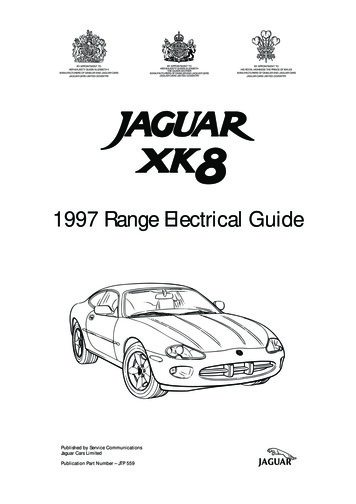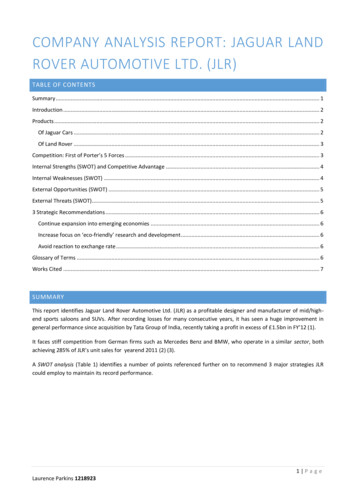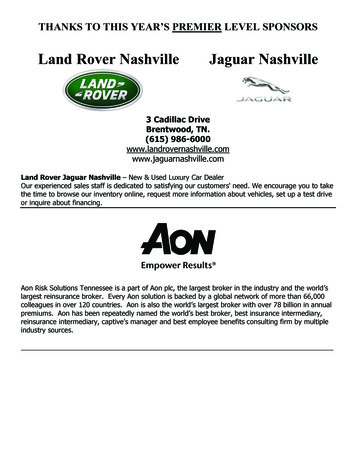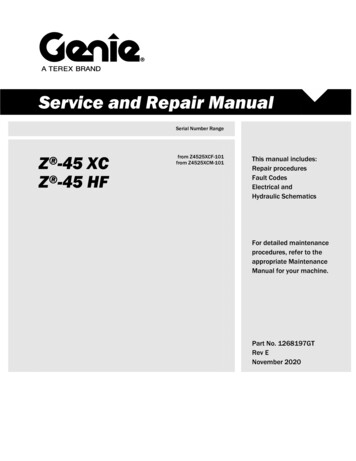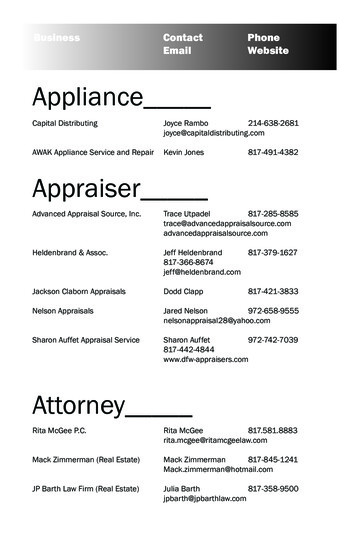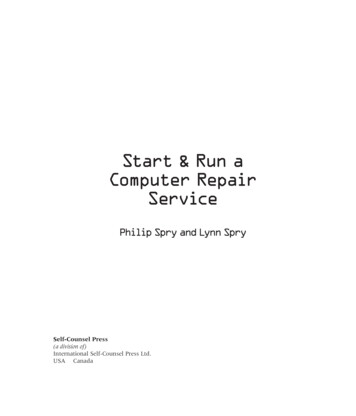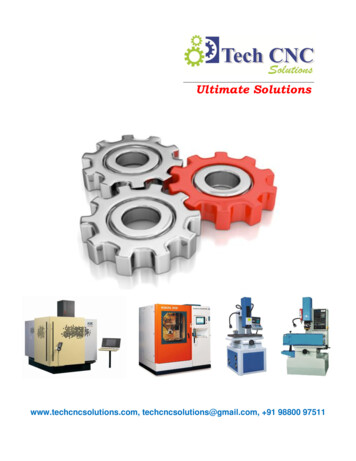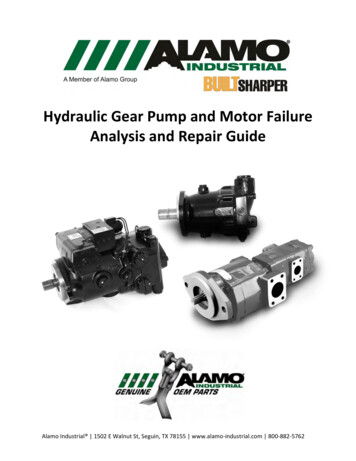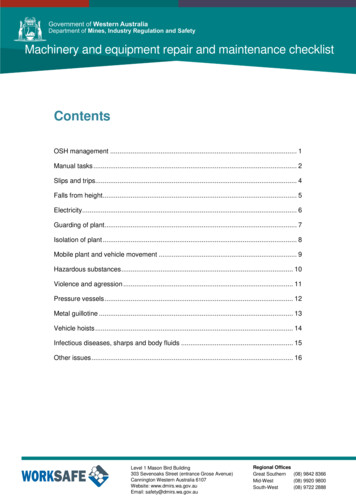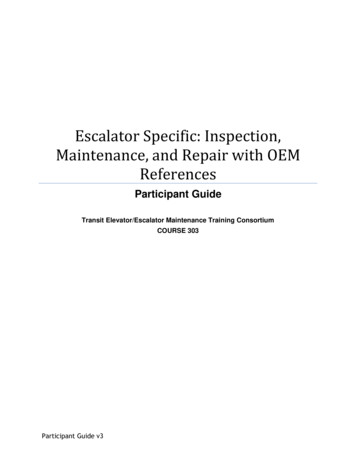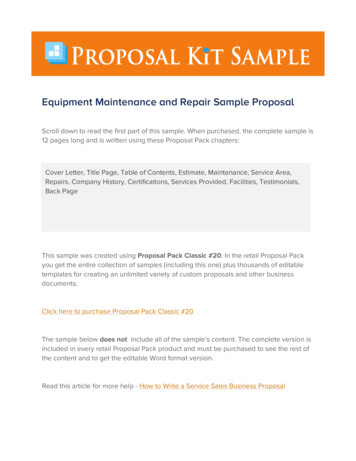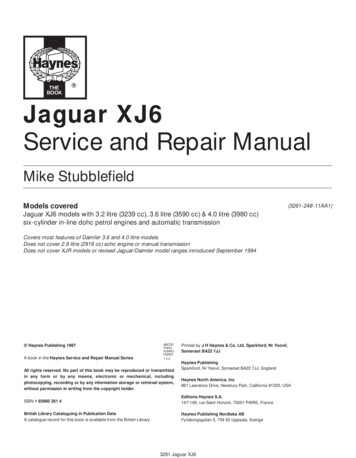
Transcription
Jaguar XJ6Service and Repair ManualMike StubblefieldModels covered(3261-248-11AA1)Jaguar XJ6 models with 3.2 litre (3239 cc), 3.6 litre (3590 cc) & 4.0 litre (3980 cc)six-cylinder in-line dohc petrol engines and automatic transmissionCovers most features of Daimler 3.6 and 4.0 litre modelsDoes not cover 2.9 litre (2919 cc) sohc engine or manual transmissionDoes not cover XJR models or revised Jaguar/Daimler model ranges introduced September 1994 Haynes Publishing 1997A book in the Haynes Service and Repair Manual SeriesABCDEFGHIJKLMNOPQRST123All rights reserved. No part of this book may be reproduced or transmittedin any form or by any means, electronic or mechanical, includingphotocopying, recording or by any information storage or retrieval system,without permission in writing from the copyright holder.Printed by J H Haynes & Co. Ltd, Sparkford, Nr Yeovil,Somerset BA22 7JJHaynes PublishingSparkford, Nr Yeovil, Somerset BA22 7JJ, EnglandHaynes North America, Inc861 Lawrence Drive, Newbury Park, California 91320, USAISBN 1 85960 261 4Editions Haynes S.A.147/149, rue Saint Honoré, 75001 PARIS, FranceBritish Library Cataloguing in Publication DataA catalogue record for this book is available from the British Library.Haynes Publishing Nordiska ABFyrisborgsgatan 5, 754 50 Uppsala, Sverige3261 Jaguar XJ6
ContentsLIVING WITH YOUR JAGUAR XJ6IntroductionPage 0 4Notes for UK readersPage 0 4Safety first!Page 0 5Roadside repairsIntroductionPage 0 6If your car won’t startPage 0 6Jump startingPage 0 7Wheel changingPage 0 8Identifying leaksPage 0 9TowingPage 0 9Weekly checksIntroductionPage 0 10Underbonnet check pointsPage 0 10Engine oil levelPage 0 11Coolant levelPage 0 11Brake fluid levelPage 0 12Screen washer fluid levelPage 0 12Power steering fluid levelPage 0 13Wiper bladesPage 0 13Tyre condition and pressurePage 0 14BatteryPage 0 15Bulbs and fusesPage 0 15Lubricants, fluids and tyre pressuresPage 0 16MAINTENANCERoutine maintenance and servicingPage 1 1Servicing specificationsPage 1 2Maintenance schedulePage 1 3Maintenance proceduresPage 1 63261 Jaguar XJ6
ContentsREPAIRS & OVERHAULEngine and associated systemsEngine in-car repair proceduresPage 2A 1Engine removal and overhaul proceduresPage 2B 1Cooling, heating and air conditioning systemsPage 3 1Fuel and exhaust systemsPage 4 1Engine electrical systemsPage 5 1Emissions and engine cone control systemsPage 6 1TransmissionAutomatic transmissionPage 7 1DrivetrainPage 8 1Brakes and suspensionBraking systemPage 9 1Suspension and steering systemsPage 10 1Body equipmentBodywork and fittingsPage 11 1Body electrical systemsPage 12 1Wiring diagramsPage 12 16REFERENCEDimensions and weightsPage REF 1Jacking and vehicle supportPage REF 1Radio/cassette unit anti-theft system - precautionPage REF 1Conversion factorsPage REF 2Use of EnglishPage REF 3Buying spare parts and vehicle identificationPage REF 4General repair proceduresPage REF 5Tools and working facilitiesPage REF 6MOT test checksPage REF 8Fault findingPage REF 12Glossary of technical termsPage REF 18IndexPage REF 223261 Jaguar XJ6
0 4IntroductionThese models are equipped with dual overhead cam in-line sixcylinder engines. The engines feature a computer-controlled ignitionsystem and electronic fuel injection. Transmissions are a four-speedautomatic equipped with a lock-up torque converter. The transmissionis mounted to the back of the engine, and power is transmitted to thefully independent rear axle through a two-piece propshaft. Thedifferential is bolted solidly to a frame crossmember and drives thewheels through driveshafts equipped with inner and outer U-joints.The front suspension is fitted with upper and lower control arms, coilsprings and shock absorbers. The rear suspension is an independenttype suspension which also have coil spring/shock absorberassemblies and a lower control arm. The rear driveshaft acts as theupper control arm.Power-assisted Anti-lock Brake Systems (ABS) with four-wheel discbrakes are standard equipment on all Jaguar XJ6 models covered inthis manual. Power rack-and-pinion steering is also standardequipment.Your Jaguar manualThe aim of this manual is to help you get the best value from yourvehicle. It can do so in several ways. It can help you decide what workmust be done (even should you choose to get it done by a garage). Itwill also provide information on routine maintenance and servicing, andgive a logical course of action and diagnosis when random faultsoccur. However, it is hoped that you will use the manual by tackling thework yourself. On simpler jobs it may even be quicker than booking thecar into a garage and going there twice, to leave and collect it. Perhapsmost important, a lot of money can be saved by avoiding the costs agarage must charge to cover its labour and overheads.The manual has drawings and descriptions to show the function ofthe various components so that their layout can be understood. Tasksare described and photographed in a clear step-by-step sequence.Notes for UK readersBecause this manual was originally written in the US, its layoutdiffers from our UK-originated manuals. The preliminary and referencesections have been re-written specifically for the UK market, and themaintenance schedule has been amended to suit UK vehicles.However, it will be noticed that some references to componentsremain in the US style; the UK equivalent of US components andvarious other US words is given in the Section headed “Use ofEnglish”. It should be remembered that the project vehicle used in themain Chapters of this manual was a left-hand drive US model;therefore, the position of the steering wheel, steering column andpedals, etc. will be on the opposite side of the vehicle on UK models.References to “right” and “left” will need to be considered carefully todecide which applies to UK models (eg the headlight dipped beamsshould be adjusted to dip to the left of the headlight vertical linedescribed in Chapter 12, instead of to the right on US models). In otherinstances, no reference is made to the location of a particular item, butthat item may be located on the opposite side of the vehicle on UKmodels. Reference to the underbonnet photos at the start of Chapter 1will give the reader the location of the engine compartmentcomponents on UK models.All specifications in the main Chapters of the manual appear inImperial form; the equivalent metric values can be calculated using the“Conversion factors” page.The only other major difference between UK and US models is in thelevel of emission control equipment fitted to the vehicle. To meet thestrict emission standards present in the US, all vehicles for that marketare fitted with various emission control systems (see Chapter 6), mostof which are not fitted to the corresponding UK model, especially so onearly models. Therefore, a lot of the information contained in Chapter 6is not applicable to UK models.AcknowledgementsThanks are due to Jean Preis, Rich Wilson and Ray Marcuse ofSilver Star Jaguar (Thousand Oaks, CA), Rick Calaci of Conejo Imports(Newbury Park, CA) and Jim Strohmeier and Jonathan Lund of BritishMotor Cars (Thousand Oaks, CA), for providing valuable technicalinformation. Technical writers who contributed to this project includeJeff Kibler, Robert Maddox and Jay Storer.We take great pride in the accuracy of information given in thismanual, but vehicle manufacturers make alterations and designchanges during the production run of a particular vehicle of whichthey do not inform us. No liability can be accepted by the authorsor publishers for loss, damage or injury caused by any errors in, oromissions from, the information given.Haynes mechanic, author and photographer with 1989 Jaguar XJ63261 Jaguar XJ6
Safety first!Working on your car can be dangerous.This page shows just some of the potentialrisks and hazards, with the aim of creating asafety-conscious attitude.General hazardsScalding Don’t remove the radiator or expansiontank cap while the engine is hot. Engine oil, automatic transmission fluid orpower steering fluid may also be dangerouslyhot if the engine has recently been running.Burning Beware of burns from the exhaust systemand from any part of the engine. Brake discsand drums can also be extremely hotimmediately after use.Crushing When working under or neara raised vehicle,alwayssupplement thejack with axlestands, or usedrive-onramps.Neverventureunder a car whichis only supported by a jack. Take care if loosening or tightening hightorque nuts when the vehicle is on stands.Initial loosening and final tightening shouldbe done with the wheels on the ground. Mains voltage is also dangerous. Makesure that any mains-operated equipment iscorrectly earthed. Mains power points shouldbe protected by a residual current device(RCD) circuit breaker.Fume or gas intoxication Exhaust fumes arepoisonous; they oftencontain carbonmonoxide, which israpidly fatal if inhaled.Never run theengine in aconfined spacesuch as a garagewith the doors shut. Fuel vapour is alsopoisonous, as are the vapours from somecleaning solvents and paint thinners.Poisonous or irritant substances Avoid skin contact with battery acid andwith any fuel, fluid or lubricant, especiallyantifreeze, brake hydraulic fluid and Dieselfuel. Don’t syphon them by mouth. If such asubstance is swallowed or gets into the eyes,seek medical advice. Prolonged contact with used engine oil cancause skin cancer. Wear gloves or use abarrier cream if necessary. Change out of oilsoaked clothes and do not keep oily rags inyour pocket. Air conditioning refrigerant forms apoisonous gas if exposed to a naked flame(including a cigarette). It can also cause skinburns on contact.FireAsbestos Fuel is highly flammable; fuel vapour isexplosive. Don’t let fuel spill onto a hot engine. Do not smoke or allow naked lights(including pilot lights) anywhere near avehicle being worked on. Also beware ofcreating sparks(electrically or by use of tools). Fuel vapour is heavier than air, so don’twork on the fuel system with the vehicle overan inspection pit. Another cause of fire is an electricaloverload or short-circuit. Take care whenrepairing or modifying the vehicle wiring. Keep a fire extinguisher handy, of a typesuitable for use on fuel and electrical fires. Asbestos dust can cause cancer if inhaledor swallowed. Asbestos may be found ingaskets and in brake and clutch linings.When dealing with such components it issafest to assume that they contain asbestos.Electric shock Ignition HTvoltage can bedangerous,especially topeople with heartproblems or apacemaker. Don’twork on or near theignition system withthe engine running orthe ignition switched on.0 5Special hazardsHydrofluoric acid This extremely corrosive acid is formedwhen certain types of synthetic rubber, foundin some O-rings, oil seals, fuel hoses etc, areexposed to temperatures above 4000C. Therubber changes into a charred or stickysubstance containing the acid. Once formed,the acid remains dangerous for years. If itgets onto the skin, it may be necessary toamputate the limb concerned. When dealing with a vehicle which hassuffered a fire, or with components salvagedfrom such a vehicle, wear protective glovesand discard them after use.The battery Batteries contain sulphuric acid, whichattacks clothing, eyes and skin. Take carewhen topping-up or carrying the battery. The hydrogen gas given off by the batteryis highly explosive. Never cause a spark orallow a naked light nearby. Be careful whenconnecting and disconnecting batterychargers or jump leads.Air bags Air bags can cause injury if they go offaccidentally. Take care when removing thesteering wheel and/or facia. Special storageinstructions may apply.Diesel injection equipment Diesel injection pumps supply fuel at veryhigh pressure. Take care when working onthe fuel injectors and fuel pipes.Warning: Never expose the hands,face or any other part of the bodyto injector spray; the fuel canpenetrate the skin with potentially fatalresults.Remember.A few tipsDODON’T Do use eye protection when using powertools, and when working under the vehicle. Don’t attempt to lift a heavy componentwhich may be beyond your capability – getassistance. Do wear gloves or use barrier cream toprotect your hands when necessary. Do get someone to check periodicallythat all is well when working alone on thevehicle. Do keep loose clothing and long hair wellout of the way of moving mechanical parts. Do remove rings, wristwatch etc, beforeworking on the vehicle – especially theelectrical system. Do ensure that any lifting or jackingequipment has a safe working load ratingadequate for the job.3261 Jaguar XJ6 Don’t rush to finish a job, or takeunverified short cuts. Don’t use ill-fitting tools which may slipand cause injury. Don’t leave tools or parts lying aroundwhere someone can trip over them. Mopup oil and fuel spills at once. Don’t allow children or pets to play in ornear a vehicle being worked on.
0 6Roadside repairsThe following pages are intended to help in dealing withcommon roadside emergencies and breakdowns. You will findmore detailed fault finding information at the back of themanual, and repair information in the main chapters.If your car won’t startand the starter motordoesn’t turnIf your car won’t starteven though the startermotor turns as normalM If it’s a model with automatic transmission, make sure theselector is in ‘P’ or ‘N’.M Open the bonnet and make sure that the battery terminalsare clean and tight.M Switch on the headlights and try to start the engine. If theheadlights go very dim when you’re trying to start, thebattery is probably flat. Get out of trouble by jump starting(see next page) using a friend’s car.M Is there fuel in the tank?M Is there moisture on electrical components under thebonnet? Switch off the ignition, then wipe off any obviousdampness with a dry cloth. Spray a water-repellent aerosolproduct (WD-40 or equivalent) on ignition and fuel systemelectrical con
3261 Jaguar XJ6 REPAIRS & OVERHAUL Engine and associated systems Engine in-car repair procedures Page 2A 1 Engine removal and overhaul procedures Page 2B 1 Cooling, heating and air conditioning systems Page 3 1 Fuel and exhaust systems Page 4 1 Engine electrical systems Page 5 1 Emissions and engine cone control systems Page 6 1 Transmission
